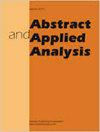二阶奇摄动混合位移微分差分方程的拟合数值格式
Q3 Mathematics
引用次数: 1
摘要
本文研究了具有时滞和提前参数的奇摄动微分差分方程。所提出的数值格式是奇异摄动微分方程在节点处的拟合四阶有限差分近似,并获得了一个三对角格式。这一点意义重大,因为所提出的方法适用于小于网格大小的扰动参数,而大多数数值方法都无法给出良好的结果。此外,这项工作还可以帮助介绍建立和分析所提出的数值方法的稳定性和收敛性的技术,这是数值分析的关键部分。最大绝对误差范围从10−03到10−10,对于所考虑的数值示例,列出了扰动参数、延迟和提前参数以及网格大小的不同值的计算收敛率。简单地说,与文献中报道的一些现有的数值方法相比,本方法是稳定和收敛的,并且给出了更准确的结果。本文章由计算机程序翻译,如有差异,请以英文原文为准。
Fitted Numerical Scheme for Second-Order Singularly Perturbed Differential-Difference Equations with Mixed Shifts
This paper presents the study of singularly perturbed differential-difference equations of delay and advance parameters. The proposed numerical scheme is a fitted fourth-order finite difference approximation for the singularly perturbed differential equations at the nodal points and obtained a tridiagonal scheme. This is significant because the proposed method is applicable for the perturbation parameter which is less than the mesh size
,
where most numerical methods fail to give good results. Moreover, the work can also help to introduce the technique of establishing and making analysis for the stability and convergence of the proposed numerical method, which is the crucial part of the numerical analysis. Maximum absolute errors range from
10
−
03
up to
10
−
10
, and computational rate of convergence for different values of perturbation parameter, delay and advance parameters, and mesh sizes are tabulated for the considered numerical examples. Concisely, the present method is stable and convergent and gives more accurate results than some existing numerical methods reported in the literature.
求助全文
通过发布文献求助,成功后即可免费获取论文全文。
去求助
来源期刊
CiteScore
2.30
自引率
0.00%
发文量
36
审稿时长
3.5 months
期刊介绍:
Abstract and Applied Analysis is a mathematical journal devoted exclusively to the publication of high-quality research papers in the fields of abstract and applied analysis. Emphasis is placed on important developments in classical analysis, linear and nonlinear functional analysis, ordinary and partial differential equations, optimization theory, and control theory. Abstract and Applied Analysis supports the publication of original material involving the complete solution of significant problems in the above disciplines. Abstract and Applied Analysis also encourages the publication of timely and thorough survey articles on current trends in the theory and applications of analysis.

 求助内容:
求助内容: 应助结果提醒方式:
应助结果提醒方式:


